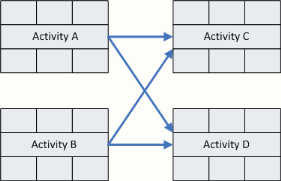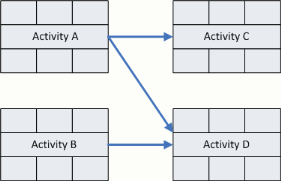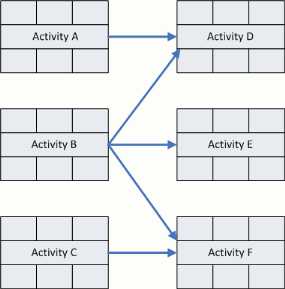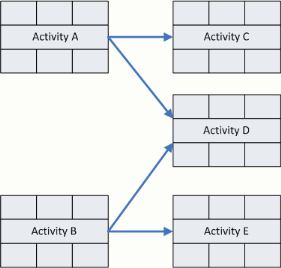precedence diagram notation
Unlike Arrow Diagramming that uses the arrows for activities and nodes for the start and end of activities, Precedence Diagramming places the activity on the nodes and uses arrows between the nodes to show the sequence between each activity. Precedence Diagramming is also called "activity-on-the-node".
To illustrate the Precedence Diagramming method, the illustrations below show several different schedule fragments. You may want to compare notes between the fragments shown here for the Precedence Diagram, and their counterparts in the Arrow Diagramming method.
example 1
| Activity | Prior Activity |
|---|---|
| A | None |
| B | A |

example 2
| Activity | Prior Activity |
|---|---|
| A | None |
| B | A |
| C | A |

example 3
| Activity | Prior Activity |
|---|---|
| A | None |
| B | None |
| C | A, B |
| D | A, B |

As described in the section on the Arrow Diagramming method the set of all activities and their related sequence is called a "network".
Another item previously covered also bears repeating here. The definition of a project is something with a specific beginning and end. Activities should be included in the network that start and end the project. For most construction contracts these activities related to contractual dates such as the Notice To Proceed and the calculated Contract Completion Date.
Precedence Diagramming separates the definition of activities from their sequence. The activities are of the nodes and the sequence is on the arrows. As a result, the use of dummy logic arrows, required in the Arrow Diagram, is not required in the Precedence Diagram. Letís look at a few schedule fragments that caused difficulty for the Arrow Diagram and see what they look like in the Precedence Diagram.
The first example shows how the Precedence Diagram represents a sequence of activities where sets of activities share some, but not all, of the prior activities. In this example, Activity C has a prior of A and Activity B has both A and B as priors.
| Activity | Prior Activity |
|---|---|
| A | None |
| B | None |
| C | A |
| D | A, B |

The following sequence of activities also demonstrates the ease with which the Precedence Method is able to represent activities that share different sets of priors. In the Arrow Diagram, the following sequence of activities requires two dummy activities.
| Activity | Prior Activity |
|---|---|
| A | None |
| B | None |
| C | None |
| D | A, B |
| E | B |
| F | B, C |

This final example is provided as a reference for you to check against the same activities as shown in the Arrow Diagramming method.
| Activity | Prior Activity |
|---|---|
| A | None |
| B | None |
| C | A |
| D | A, B |
| E | B |

Another implication of separating activity definition from sequence, as is done by the activity-on-the-node schedule, is that the numbering dummies are not needed as they are for activity-on-the-arrow schedules.